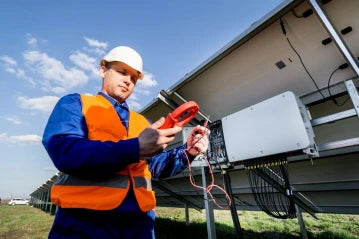
As the world moves towards a greener and more sustainable future, harnessing solar energy has become an attractive option for both homeowners and businesses. Solar panels are a key component of any solar energy system, and they play a crucial role in converting sunlight into electricity. If you're planning to invest in a solar energy system and have a 6000 Watt (W) inverter, you might be wondering how many solar panels you need to power your energy requirements. In this blog post, we'll walk you through the process of determining the ideal number of solar panels for your 6000W inverter setup, ensuring that you get the most out of your solar investment.
1. Understanding Your Energy Needs
Before diving into the specifics, it's essential to assess your energy needs accurately. The first step is to evaluate your average daily electricity consumption in kilowatt-hours (kWh). This information can be found on your utility bills or by contacting your electricity provider. Having a clear understanding of your energy consumption will help you gauge how many solar panels you need to offset your usage effectively.
2. Solar Panel Output and Efficiency
Solar panels come in various wattages and efficiencies, which directly impact the amount of electricity they can generate. The output of a solar panel is usually specified in Watts Peak (Wp), representing the maximum power it can produce under standard test conditions. The efficiency of a solar panel refers to its ability to convert sunlight into electricity, with higher efficiency panels generating more power per unit area.
When choosing solar panels for your 6000W inverter, opt for panels with a total output slightly higher than 6000W. This compensates for factors such as shading, temperature variations, and panel degradation over time. As a rule of thumb, selecting solar panels with a combined output of around 6600W to 7000W is a safe bet.
3. Location and Sunlight
The location of your solar panels significantly influences their performance. Different regions receive varying amounts of sunlight throughout the year, and this directly affects the efficiency of your solar panels. Areas with more sunshine generally require fewer solar panels to meet energy needs compared to regions with less sun exposure.
4. Calculating the Number of Solar Panels
Now that we have a basic understanding of our energy needs, solar panel output, and efficiency, let's calculate the number of solar panels needed for a 6000W inverter.
Step 1: Determine Daily Energy Production
Begin by converting your daily energy consumption from kWh to Watt-hours (Wh). Since there are 1000W in 1 kW and 24 hours in a day, multiply your average daily kWh consumption by 1000 to get the daily Wh consumption.
Step 2: Consider the Solar Panel Capacity Factor
The capacity factor takes into account the efficiency and weather conditions of your location. On average, most areas have a capacity factor between 15% to 20%. To be conservative, let's assume a 15% capacity factor.
Step 3: Calculate the Total Daily Energy Production
To calculate the total daily energy production of your solar panels, divide the daily Wh consumption by the capacity factor. This will give you the total daily Wh production required from your solar panels.
Step 4: Account for Inverter Efficiency
Inverters are not 100% efficient, so consider the inverter efficiency when sizing your solar array. A 6000W inverter might have an efficiency of around 95%. Divide the total daily Wh production by the inverter efficiency to get the final daily Wh production required from the solar panels.
Step 5: Determine Solar Panel Capacity
Finally, divide the daily Wh production by the average output per solar panel (let's assume 300W per panel) to get the number of solar panels needed.
5. The Right Balance
While it might be tempting to install as many solar panels as possible to generate excess electricity, it's essential to strike the right balance. Investing in too many solar panels can lead to higher upfront costs without significant additional benefits. Additionally, local regulations and available space might limit the number of panels you can install.
6. Factors to Consider
Before finalizing your solar panel purchase, consider the following factors to ensure a successful solar energy system:
a) Available Roof Space: Evaluate the available roof area to determine the maximum number of solar panels you can install. Ensure that there are no obstructions or shading that could impact the performance of your panels.
b) Panel Orientation and Tilt: Properly orienting and tilting your solar panels towards the sun optimizes their energy production. South-facing panels typically receive the most sunlight in the Northern Hemisphere, while north-facing panels work best in the Southern Hemisphere.
c) Future Energy Needs: Anticipate any changes in your energy consumption in the future. If you plan to expand your household or business, it's wise to accommodate potential increases in energy needs.
Conclusion
Determining the number of solar panels required for a 6000W inverter involves understanding your energy needs, the output and efficiency of solar panels, and the location's sunlight conditions. By calculating the daily energy production and accounting for factors like the capacity factor and inverter efficiency, you can ensure a well-sized solar array for your energy requirements. Remember to strike the right balance between the number of solar panels, available roof space, and future energy needs to make the most out of your solar investment.
Going solar not only helps you save on electricity bills but also contributes to a cleaner and more sustainable planet. So, whether you're a homeowner or a business owner, investing in solar energy is a decision that benefits both your finances and the environment.

0 Kommentare